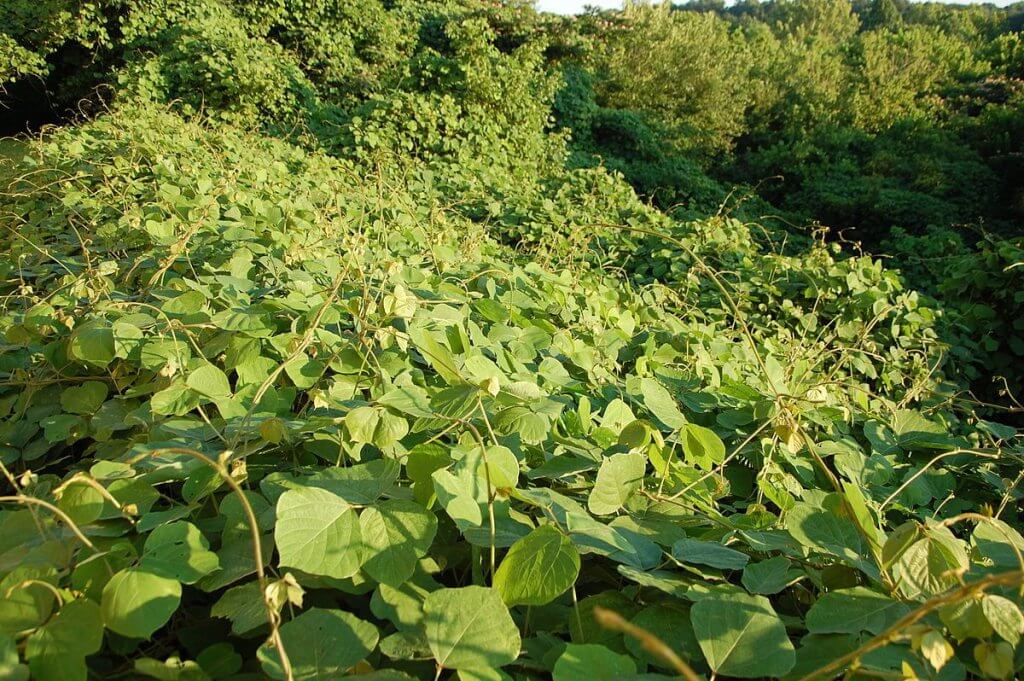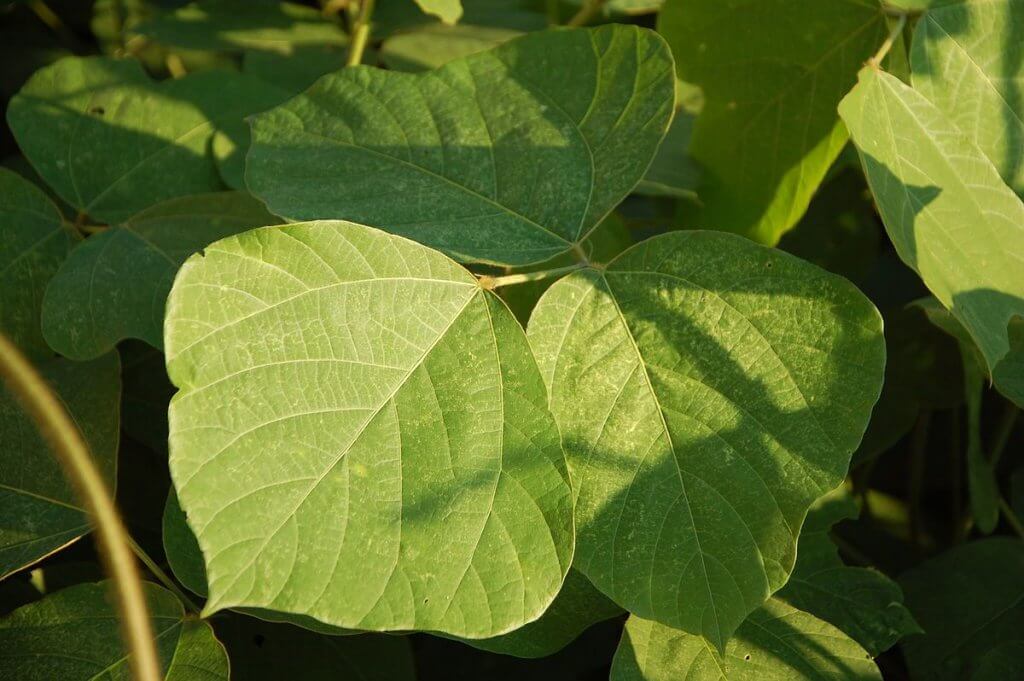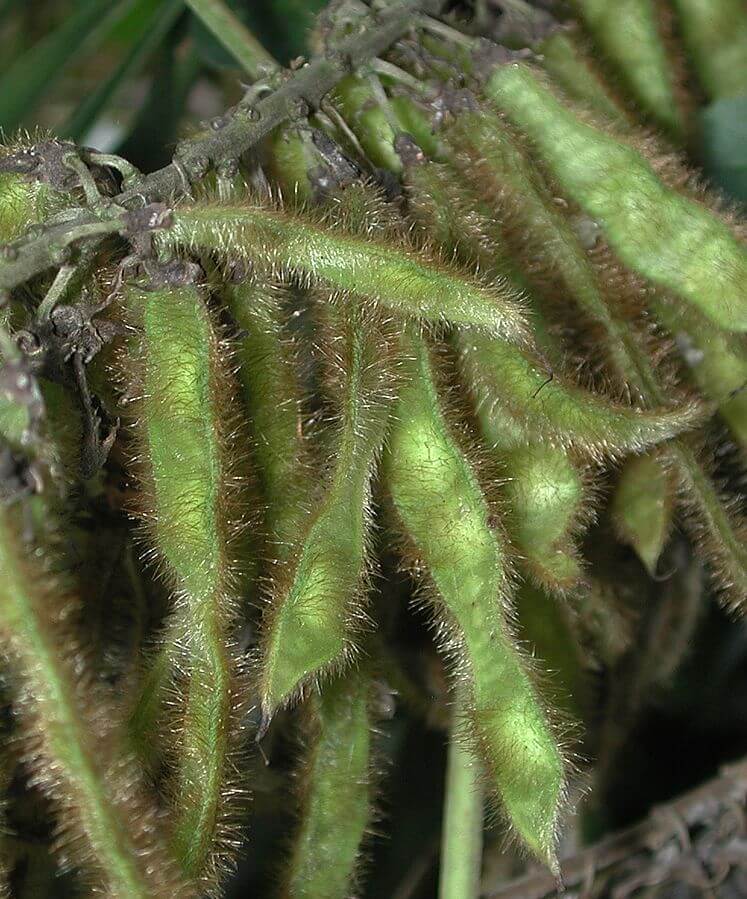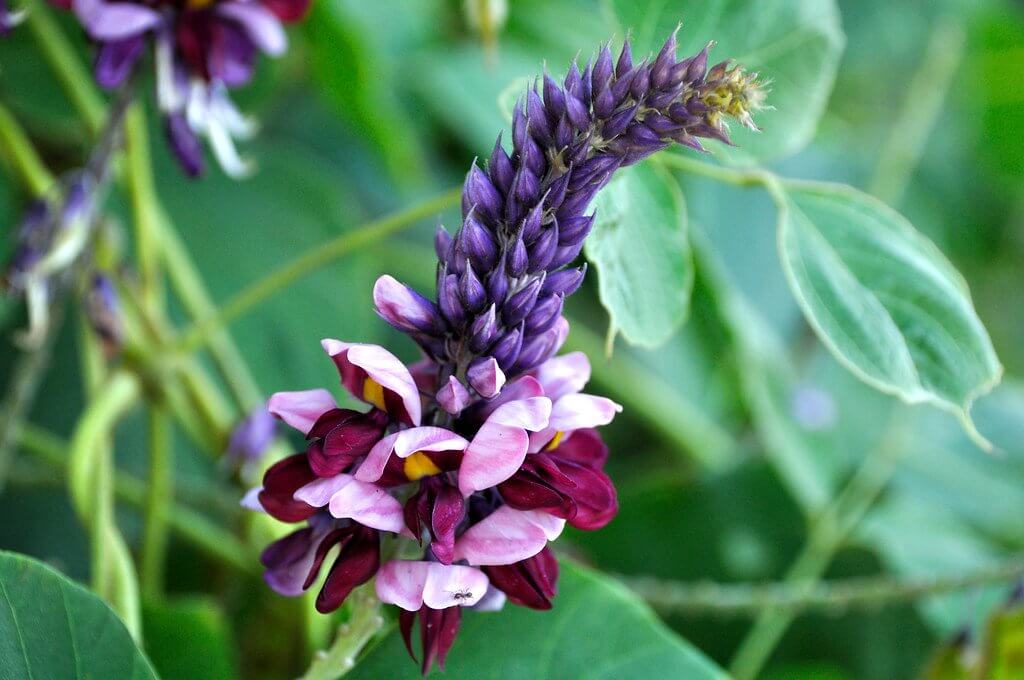Kudzu (Pueraria Montana), also known as Japanese arrowroot, is a perennial blossoming vine that is native to large areas of Southeast Asia. This plant was originally brought over to the US from Japan in the 1800s to be cultivated as livestock feed. Farmers were encouraged to plant fields of Kudzu before its invasive nature was discovered. It was a time before the complex processes of ecosystems were known. And it was before any form of habitat or species protection was enforced. Because of this, it has had devasting impacts on native plant species within parts of the US.
“The vine that ate the South”
Over time, Kudzu can become an incredibly invasive weed that can threaten nearby plants. Its broad leaves block essential sunlight to low-growing plants and seedlings, and the extensive root systems will compete with other plants for nutrients.
In a matter of years, Kudzu can kill a vast area of surrounding native plant life, and unfortunately, it is widely naturalized across the US. It’s especially rampant in the South and Southeastern states, giving it the poignant name, “the vine that ate the south”. As knowledge of its invasive nature grew, the plant was soon banned within Europe and countries like New Zealand, where it poses a threat to non-native ecosystems.

As an invasive species, kudzu has some interesting uses that make it a plant worth foraging — which in turn could help to reduce population numbers. You can eat almost all parts of this plant, except for its seeds and seed pods. Moreover, kudzu can also be used as a herbal remedy for many ailments and it has been used in traditional Chinese medicine for centuries.
Can You Eat Kudzu? Edibility and Culinary Use
Kudzu leaves, shoots, flowers, and roots are edible and safe to eat. Within Japan, the plant is even considered a staple vegetable. The leaves and young shoots can be served raw or cooked. You could add them into a salad or stir fry, or chop and add them to soups and stews. The shoots in particular work very well when deep-fried.
Then, much like the common arrowroot, kudzu roots are also full of edible starch. This starch is a powerful thickening agent which can be used in soups, stews, and sauces. Kudzu starch is also gluten-free, making it a great wheat flour substitute for those with a gluten allergy or intolerance.
Lastly, the fragrant blossoms can be served raw, cooked, or pickled. These flowers can be used as an edible garnish on salads and desserts and at the same time, they can also be made into jelly, syrup, and candy.

Tips for Foraging Kudzu
Unlike protected edible species like ramps or American ginseng, you can forage as much Kudzu as you would like due to its invasive status. The most important consideration is to make sure the plant that you’d like to harvest is safe to eat. Make sure you follow safe foraging guidelines. This is because kudzu vines are frequently sprayed with herbicides, so don’t eat them if you’re unsure whether they’ve been sprayed with chemicals or not.
Because of its rapid growth and ability to spread, Kudzu vines can be found easily throughout the country, so unfortunately it shouldn’t be hard to find kudzu vines to harvest!
After harvesting plants from the wild and preparing at home, make sure not to add the seeds or pods into your compost. The seeds may remain viable, and take root the next time you spread your homemade compost across your garden. Just remember that this plant has the potential to take over your entire garden; a single vine can grow up to 15’ to 75’ in length.
Foraging Cautions
Be careful when harvesting kudzu as its leaves could be confused with poison ivy leaves. The easiest way to differentiate both plants is to remember that kudzu is a vine that grows outwards in every direction, while poison ivy is a ground vine that grows vertically to the sky. Make sure you don’t accidentally harvest the wrong plant. For tips, check out our guide to identifying plants, but always remember if you’re unsure about the identity of a plant, don’t harvest it.
Health Benefits of Kudzu
Despite being considered a pesky weed, kudzu has numerous health benefits that are being explored in the medical field. To begin with, it’s rich in dietary fibers, making it a good and filling energy source. It’s also a great source of minerals, such as iron, sodium, calcium, potassium, copper, magnesium, and manganese. Lastly, this plant contains isoflavones which act like estrogen in the body. For this reason, it’s often used to treat menopause symptoms. Studies also suggest that kudzu’s isoflavones may be able to prevent and help treat breast cancer and uterine cancer.
Kudzu is also a popular herb among those with drinking problems. This herb can treat alcoholism and relieve hangover symptoms, such as headaches, stomach pain, nausea, and vomiting. It’s believed that kudzu can combat drinking addictions by increasing blood flow and making drinkers feel the alcohol effects sooner. This way, drinkers are more likely to drink less and stop drinking earlier.
Additionally, kudzu is also used to treat other ailments, such as cold, fever, flu, hay fever, sinus infection, migraine, upset stomach, diarrhea, dysentery, muscle pain, and neck stiffness. It can also treat skin problems, such as itchiness, rash, and psoriasis. Kudzu can help control blood sugar levels in diabetic patients as well. Lastly, it’s also great for treating cardiovascular diseases. The flavonoid-like compound in it increases blood circulation and flow. For this reason, kudzu works great to treat high blood pressure, stroke, cholesterol, angina, and even heart attacks.

(Photo by: Pollinator/Wikimedia Commons)
Kudzu Health Cautions
As with any natural remedy, if you’re taking medication that was provided by a doctor you should consult them before taking any new herbal remedies. Kudzu may slow down your blood’s ability to clot, so if you’re about to undergo surgery or have a bleeding disorder, it’s best to avoid consuming this herb.
There are also some concerns it might interfere with cardiovascular functions. It has been shown to lower blood pressure and affect heart rhythm. So, avoid it if you’re suffering from any cardiovascular diseases or undergoing cardiovascular treatments. Lastly, it can also affect blood sugar levels in diabetic patients. Pay attention to your blood sugar level when consuming this herb.

Conclusion
While Kudzu is an incredibly invasive species in non-native areas, within Asia it holds value as one of the ’50 fundamental herbs’ that hold medicinal potential. Wherever Kudzu is found growing invasively you can forage it in abundance, which in turn can help to control its spread. While the seeds and pods are not edible, if you’re foraging Kudzu it may be worth collecting and disposing of any seed pods you come across to protect the native plants in your area from being overwhelmed by this fast encroaching plant. Kudzu is a versatile wild edible that can be used in numerous recipes and explored as a medicinal herb as we try to control its population numbers.
---------------
Writen by Cornelia Tjandra
Cornelia is a freelance writer with a passion for bringing words to life and sharing useful information with the world. Her educational background in natural science and social issues has given her a broad base to approach various topics with ease. Learn more about her writing services on Upwork.com or contact her directly by email at cornelia.tjandra@gmail.com
Article updated on 01/17/22 by Hannah Sweet.
Many of our readers find that subscribing to Eat The Planet is the best way to make sure they don't miss any of our valuable information about wild edibles.
See our privacy policy for more information about ads on this site







3 Responses
I have worked in the horticulture industry for many years but to actually encourage planting an invasive species is really irresponsible and stupid. Just to start of in some states its illegal and you could face a heavy fine or even jail time… and YES there are ways of tracking who caused these things. Secondly, its absolutely immoral to spread an invasive species so it can take over more habitats causing more species to have no place to live or eat because it killed all the plant life there. I mean if you are a completely heartless person then you may not care but you don’t matter. If that doesn’t appeal to you, think about the other economical implications of constantly trying to fight it, the damage it could do to forestry practices, agriculture, etc. AND you are just casually suggesting people plant it in their back yard! whats wrong with you? you completely downplay how problematic this plant is. Dandelions can be “pesky”, Kudzu is terrible. You have obviously not worked with gardeners much. They want low maintenance and often have no clue or context about ‘fast’. they read your article and think its a great idea only to quickly get the true idea of how fast it grows and how cutting it gets tiring and too much for them. They give up on it and let it do whatever because they no longer want to deal with it. it produces seeds and now its popping up all over the neighborhood and forests and now its too late, no one is getting rid of it. thanks a lot asshole. I strongly suggest you edit this article to properly convey the true meaning of its invasive behavior and by eating it and digging up its roots for food you are helping control a real problem.
I agree with you 100% on all the points you made. This was poor oversight on my end. I am going to schedule to have this article edited or replaced ASAP.
why?!
I strongly urge you to go back and reread the article. The author is not advocating we encourage the spread of this problem plant; rather pointing out that it does have some nutritional and/or medicinal value. While it is extremely difficult to eradicate, if it can be harvested aggressively and put to good use, as we all may be starving in the very near future, it is well worth knowing that it is useful after all. For goodness sake, calm down, Karen, and learn to argue your issue(s) respectfully (p.s.: doing so makes you comes across as a more intelligent source).